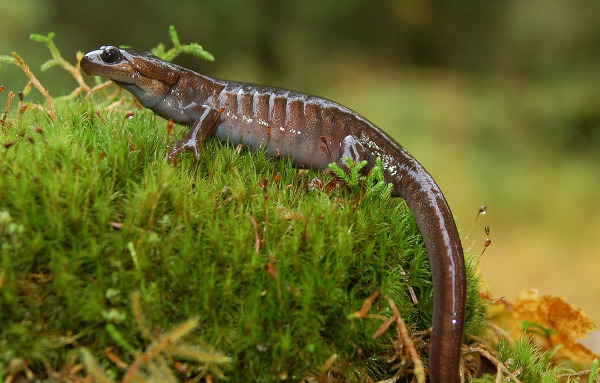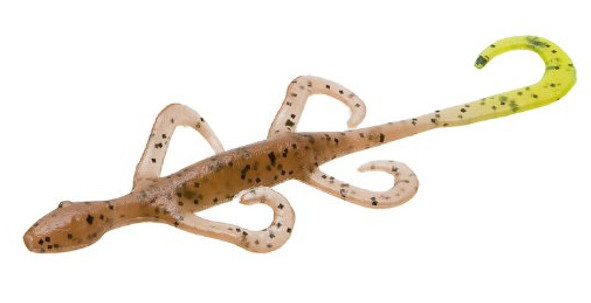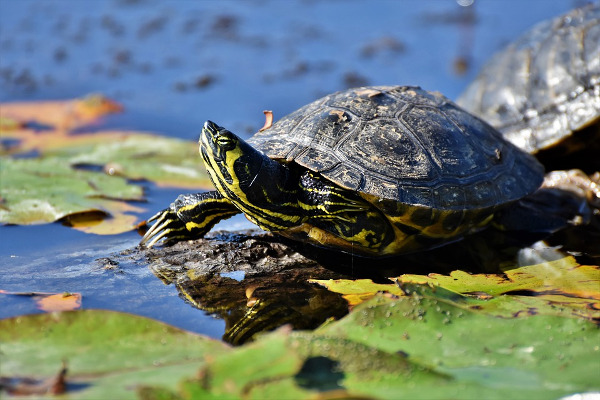Do bass eat lizards? If you listen to the marketing of many tackle companies, of course they do. Yet, I don’t see many lizards swimming in the lakes, ponds, or streams that bass make their home in. Sure, there may be a few incidental lizards entering the water to cross, but that would hardly be a common source of food for bass.

What is common in many of the waterways that hold bass are salamanders and newts. They have a similar profile to lizards, and many species spend most of their lives in the water. Salamanders are often preyed upon by bass, as they’re relatively easy targets, and offer a substantial meal.
I am referring mostly to largemouth bass in this discussion, but the points made here hold true with smallmouth bass to a lesser extent. The reason I’m focusing on largemouth bass is purley because salamanders are more likely to cross paths with a largemouth than a smallmouth due to habitat preferences.
This post uses amazon affiliate links. I receive a commission from any sales at no additional cost to yourself.
Best Time to Fish Lizard Lures
While salamanders offer a substantial source of calories, that’s not the only reason bass will attack them. Many species of salamanders (such as axolotls in the south) prey heavily on bass eggs.
Bass will attack axolotls and other salamanders on sight out of aggression, even if they’re not hungry. This is especially true during the bass spawning season. Try pitching an artificial lizard near a bass bed, I guarantee the bass will hit it. There’s a good chance it won’t swallow it, just grabbing it to move it away from the nest.
The best time to fish lizard lures is during the spring. During this time of year, fish bigger lizard patterns to maximize the chance of an aggressive reaction from the bass.
When fishing larger lizard lures, wait a bit for the bass to fully eat the bait. Bass will often grab salamanders by the tail or legs first. If you set the hook too early, you’ll just bring back a bait missing a tail or leg.
But bass are opportunistic year-round. They will also prey upon salamanders (and even actual lizards) throughout the year. Big patterns will work year-round, but you’ll have better luck if you size down a bit outside of spawn.
Best Lizard Lures?
So when you fish a lizard pattern, odds are the bass thinks it’s a salamander, not a lizard. Lure manufacturers simply call their salamander imitations lizards as it’s better marketing.

Zoom makes a good soft plastic lizard lure. Aside from being a good imitation, It’s durable and can hold up to many fish. The lures also come in a wide variety of colours. I’ve found the best colour to be the pumpkin and chartreuse pattern pictured above. 6″ is a good size that works throughout the year.
Zoom Bait 5-Inch Lizard Bait-Pack of 10 (Amazon Link)
Affordable, durable, and effective. The Zoom Lizard is a staple in many professional anglers tackle box.
How to Rig Lizard Lures?
Texas Rig
Salamanders are typically found near the bottom, so using a Texas-rig allows you to add the needed weight to get this soft plastic lures to the bottom while fishing in shallow water. A Texas-rig will also greatly reduce the number of snags.
A soft plastic lizard works well when paired with a 1/8 or 1/4 bullet weight. Use lighter weights in shallow water, and heavier weights in deeper water. You’ll typically be fishing lizards in shallow water, so heavy weights aren’t often needed.
Carolina Rig
There are situations in which you may want to fish a lizard deeper. In these situations, a Carolina Rig can be useful.
This rig is also useful if you want the lure itself to be weightless while still getting deep. It’s a good way to cover more ground than the Texas rig as the lure itself is suspended slightly above the bottom, so takes less abuse and is less likely to get snagged.
The Carolina rig is useful for both picky or deep bass.
Weightless
If you want to mimic an actual lizard rather than a salamander, this is the way to go. Cast and retrieve so its swims along the surface or just under it to represent a lizard crossing the water.
If you pause and let it sink slowly, it mimics a lizard struggling to swim, or even sinking. Bass are opportunistic so will hammer any prey that shows signs of weakness like this. This presentation in particular works well around downed tree’s, stumps, or gaps in aquatic vegetation.
What about Turtles?

It’s often said that bass will eat anything that fits in their mouth, but does this include turtles as well? Surely adult turtles are safe, but newborn turtles are quite small and would easily fit in the mouth of a largemouth bass. Does the shell prevent the bass from swallowing them easily?
Let’s look into it and find out.
What about the Shell?
You would think the shell might make the turtle hard to swallow, or at the very least hard to pass through to the other end. Baby turtles shells are thinner than adult turtles, and the shells thicken with age.
Think about one of the most common prey items of bass, the Crayfish. Crayfish have a hard exoskeleton. How do bass deal with swallowing the exoskeleton of a crayfish?
Largemouth bass actually have a way to crush prey. They have pharyngeal teeth (often referred to as “crushers”) at the back of their throat. These crushers allow the bass to swallow rigid prey such as crayfish. They also help kill potentially dangerous prey such as mice before swallowing them.
Fun fact: The taste buds of Largemouth bass are found around the crushers at the back of the throat.
The question is, can these crushers deal with a baby turtle shell? I, unfortunately, wasn’t able to find any sources that describe the crushing power of largemouth basses pharyngeal teeth, so this is still a mystery to me.
So Do Bass Eat Turtles or Not?
I was actually surprised by this one. Turns out that yes, big largemouth bass do eat baby turtles. There’s evidence of bass actually swallowing turtles (stomach contents of retained fish). I was also able to find many accounts of bass striking at baby turtles or turtle lures just out of aggression (not necessarily eating them). That’s really the question we as anglers should be asking. Not whether a bass will eat a turtle, but if it will strike at a turtle.
Bass are looking for an easy meal. They are looking for movement (or lack of movement in some cases) to trigger a feeding response. The prey drive in bass is strong. If something looks like an easy meal, there’s a good chance it’ll get a strike. Whether or not the bass can successfully swallow the prey item is an afterthought. The bass can always spit the prey item out if it can’t be swallowed.
The other side of the coin is that bass are aggressive. Oftentimes something that looks different will get a strike simply because the bass wants whatever the mystery creature is out of its area.
Turtle Lures
Most of the turtle lures on the market are geared towards saltwater fishing (which makes sense, baby sea turtles are eaten by everything). There are a few freshwater turtle lures though.
The LunkerHunt prop turtle has alot going on as far as lures go. The feet on the lure displace water in a unique way that the water your fishing probably hasn’t seen before. It’s weedless, with the option to add a stinger hook.
Lunkerhunt Prop Turtle (Amazon Link)
Bass are opportunistic predators that eat a wide variety of prey items, they’ve even been know to take birds.

3 thoughts on “Do Bass Eat Lizards? What about Turtles?”